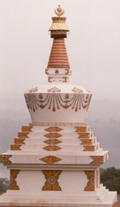 It is well known that stupas originated before the time of the Buddha.
In prehistoric times, a stupa was just a mound, located in a remote place,
where the bones or relics of a cremated king were placed. (In Sanskrit,
the word "stup" means "to heap up, pile, raise aloft,
elevate". ) Twenty-five hundred years ago, at the time of Shakyamuni
Buddha's death, a change came about in the way stupas were regarded.
It is well known that stupas originated before the time of the Buddha.
In prehistoric times, a stupa was just a mound, located in a remote place,
where the bones or relics of a cremated king were placed. (In Sanskrit,
the word "stup" means "to heap up, pile, raise aloft,
elevate". ) Twenty-five hundred years ago, at the time of Shakyamuni
Buddha's death, a change came about in the way stupas were regarded.
The Buddha requested that his relics be placed in a traditional stupa, but with a shift in context. Instead of being located in a remote place of honor, the stupa was to be located at a crossroads, so that people passing by would be reminded of the awakened state of mind.
Since the time of the Buddha's death, stupas are no longer used to revere the dead. "Stupa" in Tibetan is "chorten" or "the basis of offering", implying a basis for lay people to express devotion and connection to enlightened mind.
A stupa is an architectural representation of the entire Buddhist path as well as the result of the path -- the body, speech, and mind of an enlightened being. In particular, the serene, sacred presence of a stupa projects the wise and compassionate minds of our teachers in order to remind us, as well as those not yet born, that we have the potential for enlightenment. A stupa calls to you, and you are the stupa.
A stupa is intended to stop you in your tracks.
See Also:
The Stupa Information Page
Benefits
and Practices Related to Statues and Stupas, Part 1
Benefits
and Practices Related to Statues and Stupas, Part 2